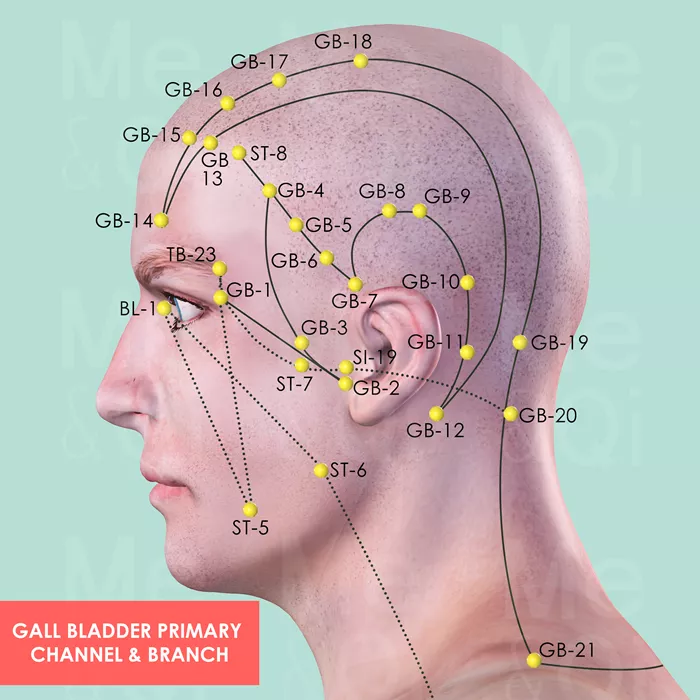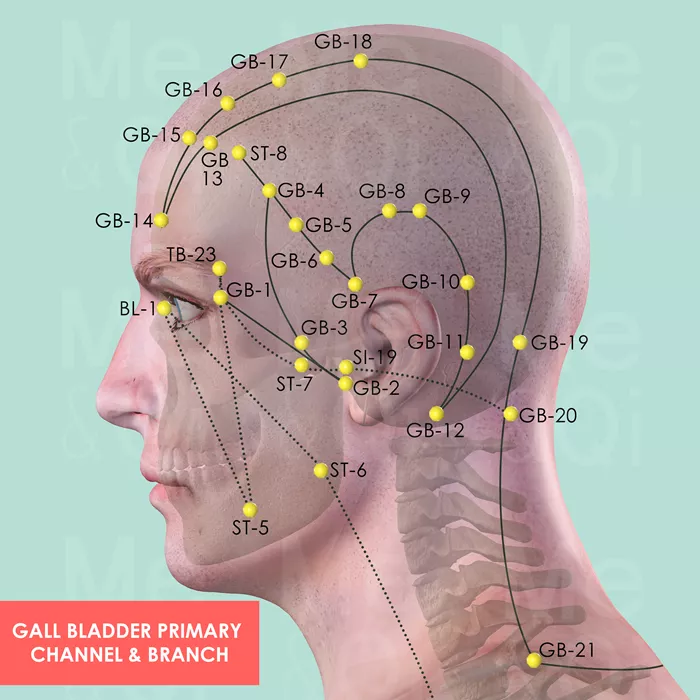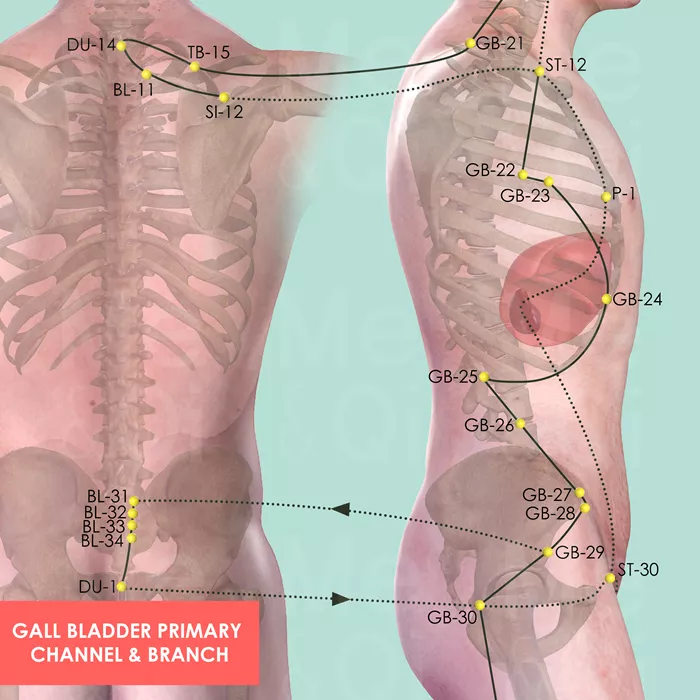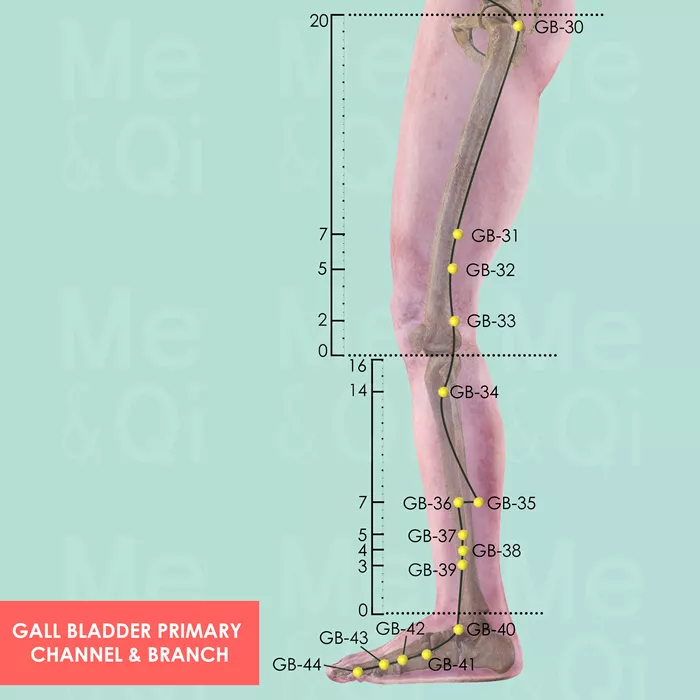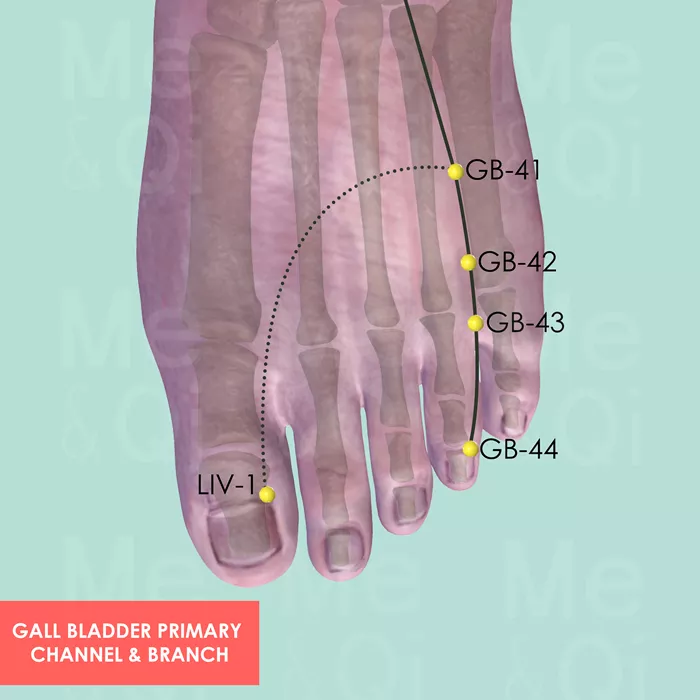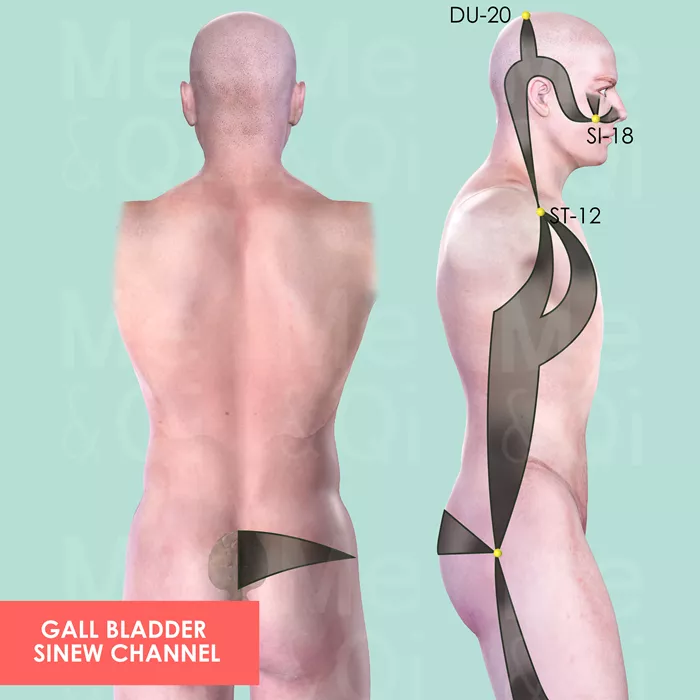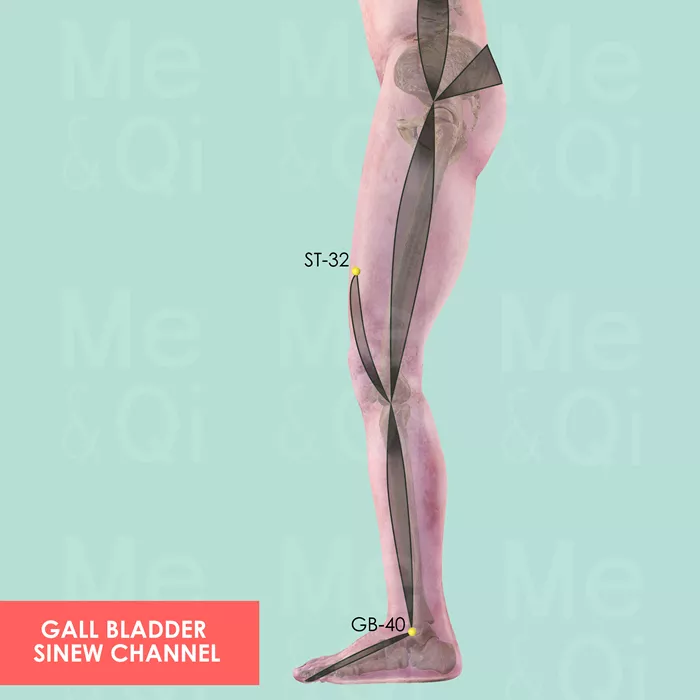Gall Bladder Channel
The acupuncture points on the Gall Bladder Channel
Gall Bladder Primary Channel
Chinese: 足少阳胆经
Pinyin: Zú Shǎo Yáng Dǎn Jīng
Pathway for Gall Bladder Primary Channel
The external pathway:
- The Gall Bladder Primary Channel originates at Tongziliao GB-1 at the outer canthus of the eye. It connects to Sizhukong TB-23 of the Triple Burner Channel through a small branch and they forms the Hand-Foot pairing of the third great circuit.
- From GB-1, the external pathway flows to Tinghui GB-2 in front of the ear and then ascends to Shangguan GB-3 at upper border of the zygomatic arch.
- After passing Touwei TB-8 at the forehead corner, it descends and passes Hanyan GB-4, Xuanlu GB-5, Xuanli GB-6 and Qubin GB-7 above the ear.
- It then curves posteriorly behind the ear all the way to Wangu GB-12 at the mastoid process below the ear.
- From there, the channel travels again all the way to Yangbai GB-14 above the supraorbital region on the forehead corner through the lateral side of the head.
- It then ascends and curves along the side of the head again to Fengchi GB-20 below the occiput.
- Afterwards, it descends and reaches Jianjing GB-21 on top of the shoulder.
- From Jianjing GB-21, the pathway passes Tianliao TB-15 on the back shoulder and then flows to Dazhui DU-14 below the spinous process of the 7th cervical vertebra (C7), where it meets the other Yang Primary Channels.
- It then runs laterally via Dazhu BL-11 as well as Bingfeng SI-12, then goes inside of the shoulder and emerges at Quepen ST-12 at the supraclavicular fossa.
- From ST-12, external pathway descends to the anterior aspect of the axilla and passes Yuanye GB-22, Zhejin GB-23 and Riyue GB-24 along the lateral thoracic wall.
- It then passes Jingmen GB-25 at the lower border of the free end of the 12th rib.
- It continues descending diagonally to Juliao GB-29 around the hip. From there, it traverses the sacral region, passing Bladder Channel (Shangliao BL-31 to Xialiao BL-34) and Governing Vessel (Changqiang DU-1).
- It then travels laterally again to Huantiao GB-30 on the buttock. This is also the point the internal branch and external pathway meets.
- The external Channel continues going down the lateral aspect of the thigh, knee and lower leg to the anterior aspect of the lateral malleolus.
- From there, it crosses the foot dorsum along the depression between the 4th and 5th metatarsal bones.
- It terminates at Zuqiaoyin GB-44 at the ulnar corner of the fourth toe nail.
Branches:
- Branch 1:
- From Fengchi GB-20 below the occiput, one internal branch separates from Primary Channel and enters the ear.
- It emerge again to the surface at Tinggong SI-19 and passes Xiaguan ST-7 in front of the ear, continuing to Tongziliao GB-1 at the lateral canthus of the eye. Descends to the corner of the jaw next to Daying ST-5, it then ascends to Jingming BL-1 in the infraorbital region, where the branch connects to the Triple Burner Channel. Descending again, it passes Jiache ST-6 on the lower jaw.
- From ST-6, the branches goes internally again through the neck, joins the main Channel at Quepen ST-12 at the supraclavicular fossa.
- Branch 2:
- From ST-12 of the supraclavicular fossa, the internal channel descends and enters the chest, crossing Pericardium Primary Channel at Tianchi P-1. Penetrating the diaphragm, it then connects to the Liver and the Gall Bladder. Continuing descending along the inside of the ribs, it enters the inguinal region via Qichong ST-30, and encircles the genitals.
- The internal branch join the main external pathway again on Huantiao GB-30.
- Branch 3:
- One external branch originates from Zulingqi GB-41 on the foot dorsum. It then runs between the 1st and 2nd metatarsal bones to Dadun LIV-1 of the medial corner of the big toe nail and connects to the Liver Channel.
Gall Bladder Divergent Channel
Chinese: 足少阳经别
Pinyin: Zú Shǎo Yáng Jīng Bié
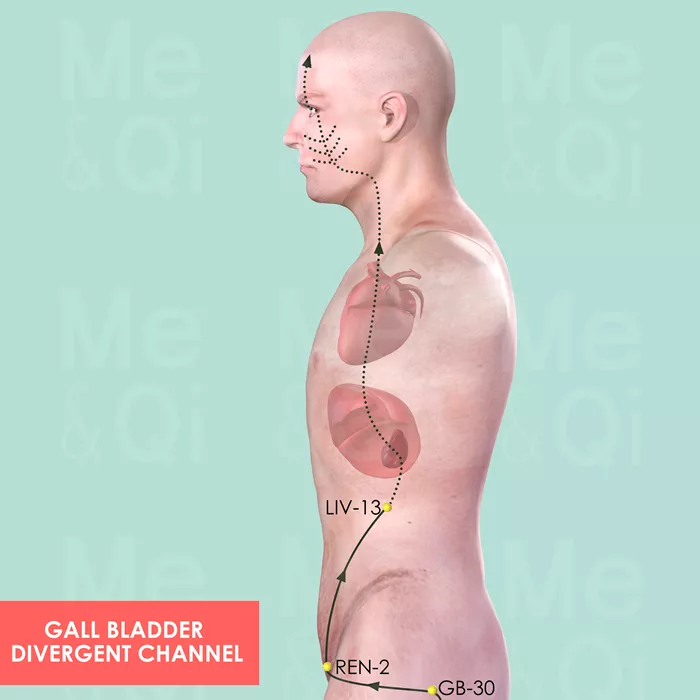
Pathway for Gall Bladder Divergent Channel
- The Gall Bladder Divergent Channel separates from the Primary Channel near Huantiao GB-30 on the buttock. Some books say the thigh is the origin.
- It crosses the hip area, enters the pubic hairline, crosses the Liver Divergent Channel and reaches Qugu REN-2 of the midline.
- It then ascends diagonally through the abdomen to Zhangmen LIV-13 below the free end of the 11th rib, where the Divergent Channel goes internally.
- It enters the flank between the lower ribs and connects with the Gall Bladder and the Liver.
- After passing the Heart and esophagus, it ascends the neck and emerges at the lower jaw.
- It then disperses on the face and meets the Gall Bladder Primary Channel at the outer canthus of the eye.
- It links to the eye system and terminates in the Brain.
Gall Bladder Sinew Channel
Chinese: 足少阳经筋
Pinyin: Zú Shǎo Yáng Jīng Jīn
Pathway for Gall Bladder Sinew Channel
- The Gall Bladder Sinew Channel starts at the 4th toe and binds around Qiuxu GB-40 at the lateral malleolus.
- It then ascends along the lateral aspect of the leg and binds at the the lateral aspect of the knee and fibula.
- A branch crosses obliquely to Futu ST-32 on the anterior aspect of the thigh and binds there.
- The main Channel ascends further and binds at the hip.
- From there, another branch separates and disperses over the gluteal and sacral area.
- The main Channel continues ascending the flank to the lower costal region. It then divides into two branches:
- One branch crosses the lateral aspect of the chest to the breast and then ascends to bind at Quepen ST-12 in the supraclavicular fossa.
- The other one follows the midaxillary line to Quepen ST-12, where it rejoins the other branch.
- From Quepen ST-12, the Sinew Channel runs up further the lateral aspect neck, curves around the ear to the temple and then ascends to Baihui DU-20 at the vertex, where it meets its bilateral counterpart.
- One branch separates from the temple, crosses the zygomatic arch to Quanliao SI-18, where it meets with the other Foot Yang Sinew Channels.
- From there, a subbranch runs to the side of the nose and binds there.
- The other subbranch ascends to bind at the outer canthus.
- One branch separates from the temple, crosses the zygomatic arch to Quanliao SI-18, where it meets with the other Foot Yang Sinew Channels.
Gall Bladder Luo-Connecting Vessel System
Chinese: 足少阳络脉
Pinyin: Zú Shǎo Yáng Luò Mài
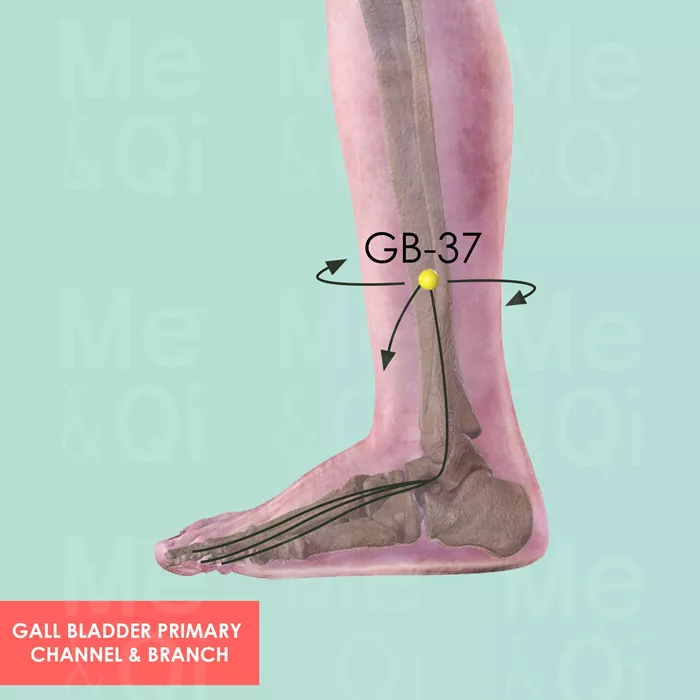
Pathway for Gall Bladder Luo-Connecting Vessel System
- Gall Bladder Luo-Connecting Vessel System separates from the Primary Channel at Guangming GB-37, on the lateral aspect of the lower leg.
- From there it forms a three-dimensional reticular network composed of various branches and subbranches.
- The main branch descends to the foot dorsum and spreads to the 3rd, 4th and 5th toes.
- The other branch connects with the Liver Primary Channel interiorly and exteriorly.

